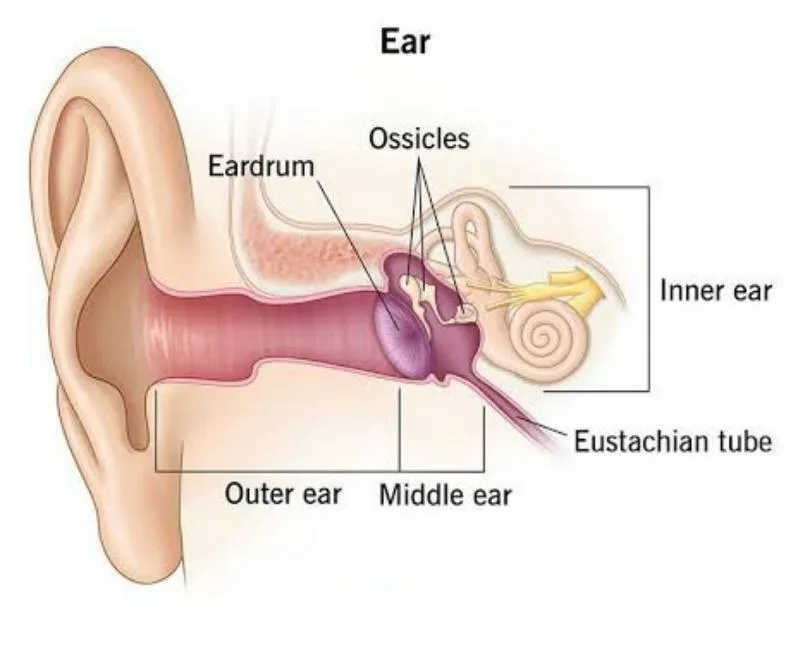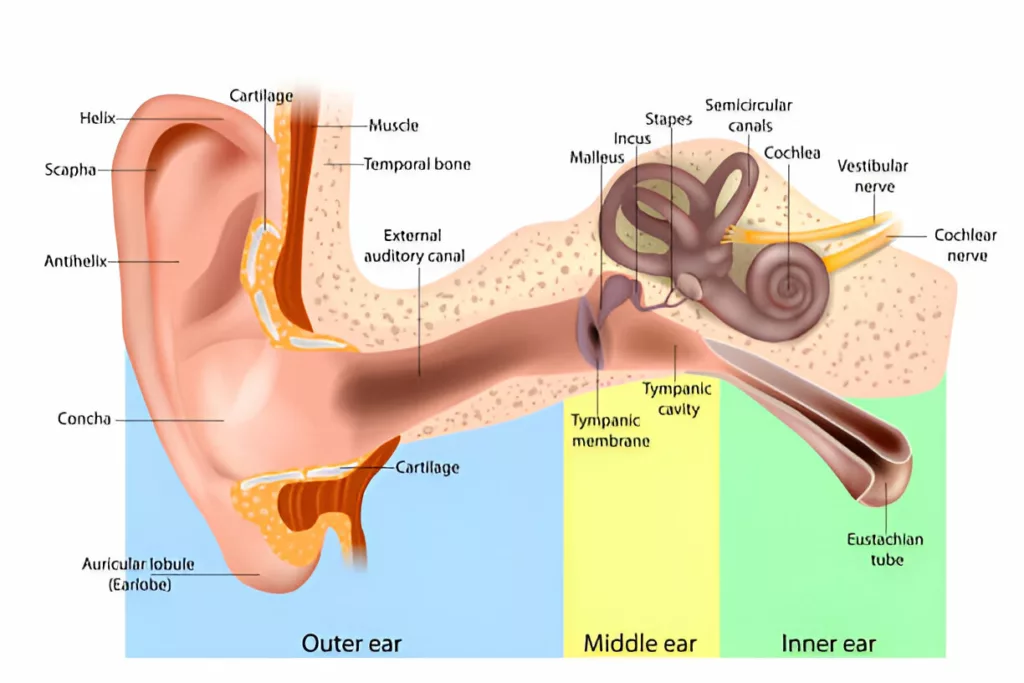Hearing is the biological process through which humans and other animals perceive sound. It involves detecting sound waves in the environment, converting them into electrical signals, and interpreting these signals in the brain. Hearing allows individuals to communicate, recognize danger, enjoy music, and engage with their surroundings.
An ear is an organ that enables hearing and aids in the body’s balance using the vestibular system. Thus, the ear serves as both the organ of hearing and balance. The outer ear receives the sound waves and passes them to the eardrum. A chain of three tiny bones conducts the vibrations from the eardrum to the inner ear. Here is the basic anatomy of the ear that will help you understand the complex hearing process.1Guyton AC, Hall JE. Textbook of Medical Physiology. 13th edition. Philadelphia: Elsevier; 2015. Chapter 49, Hearing and Balance.

Anatomy of Ear
Ear performs its vital function of hearing and has the following structural components:
- The Outer Ear
It is the outer visible part of the ear, called the pinna of the ear or auricle of the ear. The outer ear directs sound toward the inner parts of the ear. It is a cartilaginous structure with a canal leading to the eardrum or tympanic membrane. The glands in the canal produce earwax. Your outer ear performs the function of locating the origins of sounds.2Hopkins Medicine. (n.d.). *How the ear works*. Retrieved from [https://www.hopkinsmedicine.org/health/conditions-and-diseases/how-the-ear-works#:~:text=The%20Outer%20Ear&text=It%20collects%20sound%20waves%20and,where%20the%20sound%20is%20amplified](https://www.hopkinsmedicine.org/health/conditions-and-diseases/how-the-ear-works#:~:text=The%20Outer%20Ear&text=It%20collects%20sound%20waves%20and,where%20the%20sound%20is%20amplified). - The Middle Ear
The middle ear, or the tympanic cavity, is a membrane-lined, air-filled, pressurized chamber between the tympanic membrane and the cochlea. It has an opening for the Eustachian tube as well. The primary function of the middle ear is to offset the decrease in energy of sound waves that would occur if the less dense ear canal air directly contacts the more viscous cochlear fluid. - The Inner Ear
It is also called the labyrinth of the ear. This part exclusively contains the organs for the sense of hearing and equilibrium, which is responsible for your hearing and keeping your body in balance. The inner ear includes the apparatus (cochlea, organ of Corti) that allows us to perceive sound waves.
Physiology of Hearing
Receiving, transmitting, and converting sound waves into nerve signals that the brain can interpret are all part of the physiology of hearing. The ear facilitates this process.3Pickles JO. An Introduction to the Physiology of Hearing. 4th edition. New York: Academic Press; 2012.
The pinna directs sound waves into the ear canal, which leads to the eardrum (the tympanic membrane). The eardrum is a thin, cone-shaped membrane separating the outer and middle ear.
The middle ear contains three tiny bones that are called the OSSICLES:
- The Malleus
- The Incus
- Stapes
These three bones form a chain connecting the eardrum to the oval window, transmitting sound waves from the eardrum to the inner ear. The Eustachian tube equalizes the pressure on both sides of the eardrum.
The inner ear converts the mechanical energy of sound waves into electrical signals that the brain can interpret. It contains the cochlea, which is a snail-shaped organ that is filled with fluid. When sound waves reach the cochlea, they cause the fluid to vibrate. This vibration causes the hair cells to bend. This bending converts the mechanical energy of the sound waves into electrical signals. These electrical signals are then carried to the brain via the auditory nerve and interpreted through the process of auditioning.
The inner ear also contains the vestibular system, which detects motion, position, and orientation changes. It includes the semicircular canals and the otolith organs, which work together to help us maintain balance and orient ourselves in space.4InformedHealth.org [Internet]. Cologne, Germany: Institute for Quality and Efficiency in Health Care (IQWiG); 2006-. In brief: How does our sense of balance work? [Updated 2023 Sep 25]. Available from: https://www.ncbi.nlm.nih.gov/books/NBK279394/
The Role of the Tympanic Membrane in Hearing
When sound waves enter the outer ear, they pass through the ear canal and hit the tympanic membrane, aka the Eardrum. As a result, the tympanic membrane vibrates. The ossicles transmit these vibrations, amplify the sound waves, and send them to the inner ear for conversion into nerve impulses.

Damage or perforation of the tympanic membrane can interfere with the transmission of sound waves and cause hearing loss.5http://Dolhi N, Weimer AD. Tympanic Membrane Perforation. [Updated 2023 Aug 14]. In: StatPearls [Internet]. Treasure Island (FL): StatPearls Publishing; 2025 Jan-. Available from: https://www.ncbi.nlm.nih.gov/books/NBK557887/
In addition to its role in hearing, the tympanic membrane helps protect the middle ear from external contaminants such as dust, dirt, and water. It also helps to regulate the pressure within the middle ear by expanding and contracting in response to changes in atmospheric pressure.
Differentiation of Various Frequencies
The ear differentiates different sound frequencies using the Scala vestibuli and Scala tympani. These are two fluid-filled tubes within the inner ear that are connected to the cochlea and contain tiny hair cells that are sensitive to sound vibrations. This structure is collectively called the organ of Corti. These hair cells are arranged in a gradient, with those at the base of the cochlea being most sensitive to low frequencies and those at the top being most sensitive to high frequencies.6Bruss DM, Shohet JA. Neuroanatomy, Ear. [Updated 2023 Apr 3]. In: StatPearls [Internet]. Treasure Island (FL): StatPearls Publishing; 2025 Jan-. Available from: https://www.ncbi.nlm.nih.gov/books/NBK551658/
How Does the Cochlea Work for Hearing?
When sound waves enter the ear, they vibrate the fluid in the Scala vestibuli and Scala tympani. This vibration is transmitted to the hair cells in the cochlea, causing them to bend and produce an electrical signal that is sent to the brain for processing.
The brain can differentiate different sound frequencies based on the hair cells’ location activated by the vibration.
For example, if a low-frequency sound is heard, the hair cells at the base of the cochlea will be activated, while if a high-frequency sound is heard, the hair cells at the top of the cochlea will be activated. This allows the brain to interpret and distinguish between different sound frequencies accurately.
Conversion of Sound into Nerve Impulses
Audition is the process of converting sound waves into nerve impulses.
Specialized sensory cells in the organ of Corti, called hair cells, convert the vibrations into electrical signals that the brain can understand. The bending of the hair cells opens ion channels, allowing charged particles (ions) to flow into the cell.
The flow of ions generates an electrical current, which neurons (nerve cells) then carry to the auditory nerve and onto the brain. The magnitude of this electrical current depends on the intensity of the sound wave and the extent to which the hair cells bend.
The hair cells in the organ of corti arrange themselves to detect a wide range of frequencies, enabling us to hear a broad spectrum of sounds.7Ekdale EG. Form and function of the mammalian inner ear. J Anat. 2016 Feb;228(2):324-37.
Role of Auditory Cortex in Hearing
The auditory cortex comprises several areas responsible for different hearing aspects. For example, some areas of the auditory cortex are responsible for processing the pitch of a sound, while others are responsible for processing the volume or intensity of a sound.
The auditory cortex works in conjunction with other brain regions to allow us to understand and interpret the sounds we hear fully. For example, the auditory cortex works with the brain’s language centers to enable us to understand speech and with the brain’s memory centers to help us recognize familiar sounds.8Banich, M. T., & Compton, R. J. (2018). Fundamentals of Cognitive Neuroscience (2nd ed.). Academic Press. Retrieved from https://www.sciencedirect.com/book/9780124158054/fundamentals-of-cognitive-neuroscience.
Hearing Loss
Hearing loss is a widespread condition that can result from damage to any part of the hearing process. It affects individuals of all ages and can significantly impact communication, social interactions, and overall quality of life. The causes of hearing loss include aging, prolonged exposure to loud noise, infections, genetic factors, and certain medications.
Types of Hearing Loss
Hearing loss can be classified into three main types:
- Conductive Hearing Loss occurs when sound waves cannot reach the inner ear due to issues in the outer or middle ear, such as earwax buildup, infections, or a perforated eardrum.
- Sensorineural Hearing Loss results from damage to the inner ear or auditory nerve. It is often associated with aging (presbycusis) or prolonged exposure to loud sounds and is typically permanent.
- Mixed Hearing Loss combines elements of both conductive and sensorineural hearing loss.
In summary, the ear is responsible for receiving and transmitting sound waves and for converting those waves into electrical impulses. The vestibular system helps us maintain balance and orientation. Any disruption in the normal hearing pathway can lead to hearing loss and various hearing disorders.
Refrences
- 1Guyton AC, Hall JE. Textbook of Medical Physiology. 13th edition. Philadelphia: Elsevier; 2015. Chapter 49, Hearing and Balance.
- 2Hopkins Medicine. (n.d.). *How the ear works*. Retrieved from [https://www.hopkinsmedicine.org/health/conditions-and-diseases/how-the-ear-works#:~:text=The%20Outer%20Ear&text=It%20collects%20sound%20waves%20and,where%20the%20sound%20is%20amplified](https://www.hopkinsmedicine.org/health/conditions-and-diseases/how-the-ear-works#:~:text=The%20Outer%20Ear&text=It%20collects%20sound%20waves%20and,where%20the%20sound%20is%20amplified).
- 3Pickles JO. An Introduction to the Physiology of Hearing. 4th edition. New York: Academic Press; 2012.
- 4InformedHealth.org [Internet]. Cologne, Germany: Institute for Quality and Efficiency in Health Care (IQWiG); 2006-. In brief: How does our sense of balance work? [Updated 2023 Sep 25]. Available from: https://www.ncbi.nlm.nih.gov/books/NBK279394/
- 5http://Dolhi N, Weimer AD. Tympanic Membrane Perforation. [Updated 2023 Aug 14]. In: StatPearls [Internet]. Treasure Island (FL): StatPearls Publishing; 2025 Jan-. Available from: https://www.ncbi.nlm.nih.gov/books/NBK557887/
- 6Bruss DM, Shohet JA. Neuroanatomy, Ear. [Updated 2023 Apr 3]. In: StatPearls [Internet]. Treasure Island (FL): StatPearls Publishing; 2025 Jan-. Available from: https://www.ncbi.nlm.nih.gov/books/NBK551658/
- 7Ekdale EG. Form and function of the mammalian inner ear. J Anat. 2016 Feb;228(2):324-37.
- 8Banich, M. T., & Compton, R. J. (2018). Fundamentals of Cognitive Neuroscience (2nd ed.). Academic Press. Retrieved from https://www.sciencedirect.com/book/9780124158054/fundamentals-of-cognitive-neuroscience.

